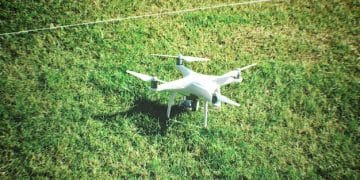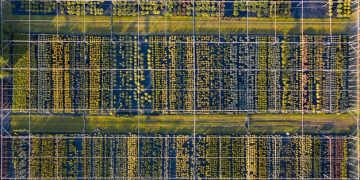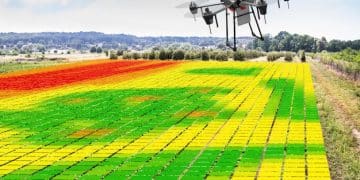AI-driven crop health monitoring: enhance your farming

AI-driven crop health monitoring uses technologies like drones and sensors to provide real-time insights, enabling farmers to optimize resource use and increase yields effectively.
AI-driven crop health monitoring is transforming agriculture, enabling farmers to make informed decisions based on data. Have you ever wondered how technology can impact your farming practices? Let’s explore this innovative approach.
Understanding AI-driven crop health monitoring
Understanding AI-driven crop health monitoring is essential for modern farming. It combines technology and agriculture to help farmers assess and improve the health of their crops.
Utilizing artificial intelligence in this field allows for real-time monitoring and analysis. By using sensors and drones, farmers can gather valuable data that informs their decisions.
Key Benefits of AI in Crop Monitoring
AI technology offers several advantages to farmers, enhancing efficiency and productivity significantly.
- Early detection: Identify crop issues before they escalate.
- Data-driven insights: Make informed decisions using accurate data.
- Resource optimization: Use inputs like water and fertilizers more efficiently.
- Higher yields: Maximize crop output with better management.
These benefits demonstrate how integrating AI into agriculture can lead to smarter farming practices. The use of machine learning algorithms helps in analyzing patterns in crop health, enabling predictions about future issues. This allows farmers to respond proactively rather than reactively.
How AI Monitors Crop Health
AI-driven crop health monitoring employs various technologies.
- Drones: Capture high-resolution images and data from above.
- Sensors: Monitor soil moisture, temperature, and nutrient levels.
- Satellite imagery: Provide insight into larger areas and trends over time.
- Mobile apps: Facilitate easy access to data for quick decision-making.
Farmers can leverage this technology by analyzing the data collected to make timely adjustments in their practices. For instance, if sensors detect low moisture levels, irrigation can be optimized right away.
Understanding AI-driven crop health monitoring is crucial. By embracing these innovations, farmers can not only protect their crops but also enhance food production sustainably. The world is moving towards a future where tech and agriculture merge, making farming more efficient and effective than ever.
Benefits of using AI for crop monitoring

Benefits of using AI for crop monitoring are transforming agriculture today. By integrating artificial intelligence into farming practices, farmers can experience enhanced efficiency and productivity.
One major advantage is the ability to gather data in real-time. This data enables farmers to monitor crop conditions constantly, leading to earlier detection of potential issues. The faster a problem is identified, the easier it is to address without significant losses.
Efficiency in Resource Usage
AI helps optimize resource usage, making farming more sustainable.
- Water management: AI algorithms can recommend irrigation schedules based on soil moisture levels.
- Pest control: Monitor fields for pest activity to apply treatments only when necessary.
- Fertilization: Tailor fertilizer applications to specific crop needs to improve nutrient uptake.
This approach not only saves costs but also protects the environment. By reducing excess inputs, farmers contribute to a healthier ecosystem.
Higher Yields and Quality
With AI monitoring, farmers often see an increase in both yield and crop quality. AI enables precise tracking of growth patterns, which helps in making informed decisions.
By using predictive analytics, farmers can understand how different conditions affect their crops. This knowledge allows them to implement best practices tailored to their specific situation.
AI-driven crop monitoring also enhances decision-making capabilities. With access to detailed data, farmers can plan ahead, scheduling activities around expected weather patterns or market demands.
Technologies involved in AI-driven monitoring
Technologies involved in AI-driven monitoring are crucial for effective crop health management. These technologies gather and analyze data from fields to help farmers make better decisions.
One of the key components is drones. Drones are equipped with cameras and sensors that capture high-resolution images of crops. They provide real-time insights into crop health, enabling farmers to identify problems quickly.
Use of Sensors
Another significant technology is sensors. These devices monitor environmental conditions directly.
- Soil moisture sensors: Measure the water content in the soil.
- Temperature sensors: Track air and soil temperature to assess growth conditions.
- Nutrient sensors: Analyze soil nutrients to determine fertilization needs.
By utilizing sensors, farmers can receive immediate feedback on their crops’ conditions, allowing for timely actions. This technology supports more precise farming practices, helping to conserve resources and enhance yields.
Artificial Intelligence Algorithms
Artificial intelligence algorithms play a critical role in interpreting the data collected. These algorithms analyze information from drones and sensors to identify trends and make predictions.
Machine learning techniques can help predict potential crop diseases or pest outbreaks based on historical data. Such predictive capabilities allow farmers to take preventive measures before problems affect their yields.
The integration of AI algorithms and data analytics tools promotes smarter farming practices. With access to actionable insights, farmers can optimize their operations and improve overall productivity.
Real-world applications of AI in agriculture

Real-world applications of AI in agriculture are making significant strides in enhancing farming practices. Farmers worldwide are harnessing artificial intelligence for various tasks, improving efficiency and outcomes.
One notable application is in precision agriculture. This involves using AI to analyze data from sensors and drones, helping farmers make informed decisions about crop management. By monitoring environmental conditions and crop health, farmers can apply water, fertilizers, and pesticides more precisely.
Crop Monitoring and Disease Detection
AI is also transforming how farmers monitor crops. Machine learning algorithms can analyze images captured by drones and identify potential diseases early. Early detection allows farmers to treat issues before they spread, preserving crop yields.
- Disease prediction: AI can predict the likelihood of disease outbreaks based on environmental data.
- Pest management: By tracking pest behavior, farmers can target interventions effectively.
- Crop health assessment: Regular monitoring detects issues quickly to reduce losses.
These applications demonstrate how AI can lead to healthier crops and better harvests.
Autonomous Farming Equipment
Another exciting application is the use of autonomous equipment. Tractors and harvesters equipped with AI technology can operate without human intervention. These machines can plant seeds, monitor fields, and harvest crops with precision.
This innovation not only reduces labor costs but also maximizes efficiency. Autonomous equipment can work continuously, ensuring that farming tasks are completed on time.
Moreover, AI software analyzes data collected by these machines, allowing farmers to optimize their practices further based on performance metrics.
AI is reshaping agriculture in incredible ways. With artificial intelligence, farmers can monitor their crops, manage resources more efficiently, and increase yields. Technology like drones and sensors allows for early detection of problems and quick decision-making. As AI continues to evolve, its applications in farming become more advanced and widespread. Embracing these innovations will lead to sustainable and productive farming practices for the future.
FAQ – Frequently Asked Questions about AI in Agriculture
How does AI improve crop monitoring?
AI enhances crop monitoring by analyzing data from sensors and drones, allowing for real-time health assessments.
What are the benefits of autonomous farming equipment?
Autonomous equipment increases efficiency by operating without human intervention, allowing farmers to focus on higher-level tasks.
Can AI help with pest control?
Yes, AI can track pest behavior and recommend targeted interventions, reducing the need for widespread pesticide use.
How do AI technologies contribute to better yields?
With precise data analysis and monitoring, AI enables farmers to make informed decisions that lead to higher crop yields.





